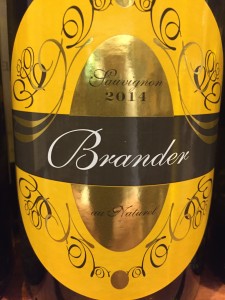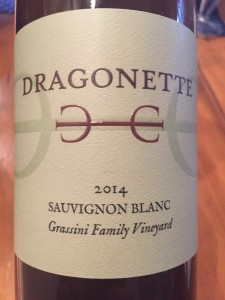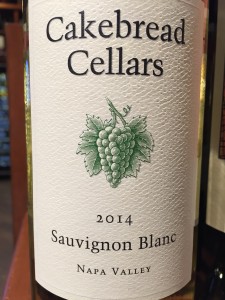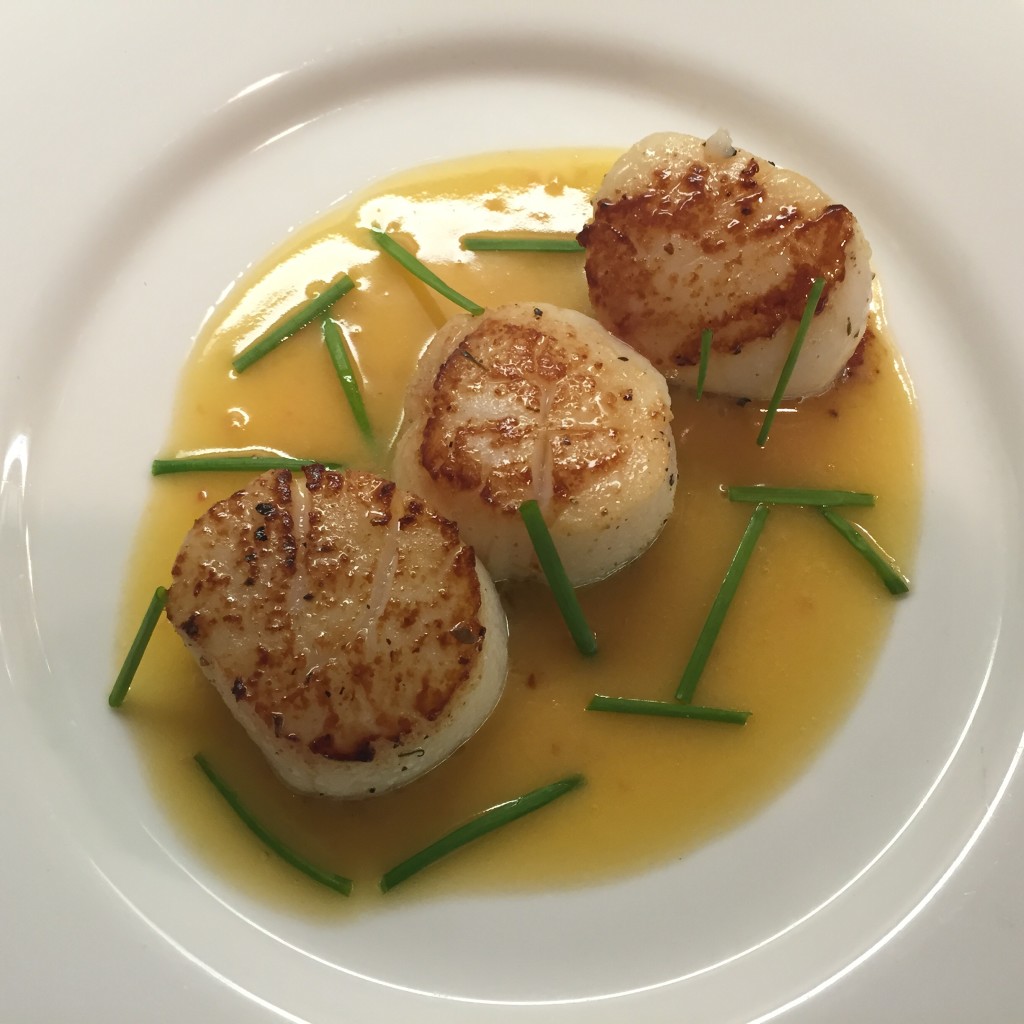Unoaked Sauv. Blanc: Brander au Natural 2014 – Pairing Rating: 8.5 out of 10.0
Oaked Sauv. Blanc: Dragonette Grassini 2014 – Pairing Rating: 8.5
Partially Oaked Sauv. Blanc: Cakebread 2014 – Pairing Rating: 9.5
Sauvignon Blanc is a chameleon. This parent-grape of Cabernet Sauvignon is grown throughout the world, with winemakers creating wines that range from crisp, steely patio sippers to rich, round food wines.
Focusing on the use of oak in Sauvignon Blanc’s fermentation process, this post will examine its influence and how the resulting styles complement a great dish that is tailor-made for Sauvignon Blanc. That dish: Seared Sea Scallops.
Raw, the scallops should smell like a fresh ocean breeze. Searing them to medium-rare results in an elegant starter or lunch course. But because the flesh of the scallop is so mild, it’s almost always served with a sauce; and the number of variations is mind-numbing: Garlic-Lemon, Lemon-Mustard, Rosemary-Lemon, Ginger-Oyster, Thai Green Curry, Korean BBQ and Miso-Glazed, to name a few. The shear number of possibilities is not unlike the Campbell’s Soup Co., which offers 74 varieties of condensed soup, according to Consumer Reports. Incredible!
How can one deal with all these options??? Our suggestion is to pick the white wine you would like to drink tonight, then find the recipe whose primary sauce ingredient will bridge the flavor profile of the wine. For example: if you want to drink a Napa Chardonnay, look for a rich butter sauce; for Chenin Blanc, go with the Rosemary-Lemon sauce; and for Riesling, try the Thai Green Curry sauce.
Trish and I were interested in checking out the various California Sauvignon Blanc styles with Scallops. Because a common flavor to nearly all Sauv Blancs is grapefruit, our recipe choice was Seared Scallops with Grapefruit Beurre Blanc from the International Culinary Center. The recipe is available online using this link:
Recipe: Seared Scallops with Grapefruit Beurre Blanc
The recipe is killer. The sauce’s butter tamed the citrus from the grapefruit and lemon juices, while the wine vinegar (we used Sherry vinegar for that beautiful rich color) added freshness. We had guests asking for a spoon so as not to leave an ounce of the sauce behind. Campbell’s can’t make that claim. More interesting to us, however, was how the use (or not) of oak in the fermentation and aging processes influenced the pairing.
 We started with a Sauvignon Blanc that was fermented in stainless steel (or concrete) and never saw a sliver of oak in the time between pressing and bottling. The Brander au Naturel from California’s Santa Ynez Valley is an excellent example of this, but there are many others including the Sauv Blanc by St. Supery and wines from New Zealand. These unoaked wines serve up bright, crisp flavors of grapefruit and lime, with a stony finish. Perfect with oysters or shrimp on the patio but not so perfect for this Scallop recipe. Both the Brander au Naturel and the St. Supery were too sharp for the delicacy of the sauce: too much refreshing acidity. A beautiful cocktail wine, but not so beautiful for this dish. Our first thought was that maybe some oak would soften the attack, rounding off the sharp edges.
We started with a Sauvignon Blanc that was fermented in stainless steel (or concrete) and never saw a sliver of oak in the time between pressing and bottling. The Brander au Naturel from California’s Santa Ynez Valley is an excellent example of this, but there are many others including the Sauv Blanc by St. Supery and wines from New Zealand. These unoaked wines serve up bright, crisp flavors of grapefruit and lime, with a stony finish. Perfect with oysters or shrimp on the patio but not so perfect for this Scallop recipe. Both the Brander au Naturel and the St. Supery were too sharp for the delicacy of the sauce: too much refreshing acidity. A beautiful cocktail wine, but not so beautiful for this dish. Our first thought was that maybe some oak would soften the attack, rounding off the sharp edges.
 In the US, some believe the standard for oaked Sauvignon Blanc is Robert Mondavi’s I Block, from the To Kalon vineyard. Recall that Mondavi launched this oaked style in 1968, calling it Fumé Blanc. Chalk Hill also produces an oaked style of Sauv Blanc. The one we tried with the Scallops was the Dragonette Cellars Grassini vineyard, from California’s Happy Canyon (Santa Ynez). Like all these oaked styled Sauv Blancs, Dragonette fermented 20% of their wine in stainless steel, while 80% was fermented in oak barrels (15% new). The oak imparts a buttery taste, almost like Crème Brulée, with softened acidity. But we felt this style was also too extreme: we needed some of that acidity back.
In the US, some believe the standard for oaked Sauvignon Blanc is Robert Mondavi’s I Block, from the To Kalon vineyard. Recall that Mondavi launched this oaked style in 1968, calling it Fumé Blanc. Chalk Hill also produces an oaked style of Sauv Blanc. The one we tried with the Scallops was the Dragonette Cellars Grassini vineyard, from California’s Happy Canyon (Santa Ynez). Like all these oaked styled Sauv Blancs, Dragonette fermented 20% of their wine in stainless steel, while 80% was fermented in oak barrels (15% new). The oak imparts a buttery taste, almost like Crème Brulée, with softened acidity. But we felt this style was also too extreme: we needed some of that acidity back.
The Goldilocks pairing was found amid the partially-oaked Sauv Blancs, where the balance between acidity and the round mouth-feel of the oak was perfect for the Grapefruit Beurre Blanc. Spottswoode is an excellent example of this style. Spottswoode ferments about 90% of the juice in stainless steel, with the balance in used and new oak.
 Cakebread Cellars follows a similar path, fermenting 88% in stainless and 12% in neutral French Oak. Cakebread then ages 70% of the wine for 5 months in oak barrels. These wines worked best with the sauce because the grapefruit in the wine was still front-and-center, while the partial oak treatment provided the finesse and mouth-feel demanded by the sauce.
Cakebread Cellars follows a similar path, fermenting 88% in stainless and 12% in neutral French Oak. Cakebread then ages 70% of the wine for 5 months in oak barrels. These wines worked best with the sauce because the grapefruit in the wine was still front-and-center, while the partial oak treatment provided the finesse and mouth-feel demanded by the sauce.
Try this Scallop recipe with one of these Sauvignon Blancs, and you too will be reaching for a spoon!

Grace Guerriere says
Hi Steven, this is Grace Guerriere from Texas; Tricia’s childhood friend. I love your blog and congratulations on your sommelier certification!
Steven says
Grace: what a nice surprise to hear from you!!! Thanks so much for your comments . . . very much appreciated. Hope all is well.
Ross Pisarkiewicz says
I love the opening paragraph, really pulled me into this delicious dish. I had no idea that Grapefruit was a common flavor in Sauvignon Blanc, great insights and recommendations!
Steven says
Thanks for commenting, Ross. Be sure to explore the Sauv Blancs made outside Cali, like New Zealand, Australia and Bordeaux. Cheers!
Linda says
Love this Steve. Makes me drool, just reading…
Steven says
Thanks, Linda. The sauce recipe is a winner! I hope you give the pairing a try.